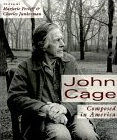John Cage: Composed in America
Last updated: 17.12.19

| Printed: | 1994 | Author: | Marjorie Perloff |
| Publisher: | University of Chicago Press | ISBN: | 0226660575 |
| Suppliers: | 






|
Paperback: 285 pages, usually ships within 24 hours.
Amazon Review
From Booklist
The late John Cage began his career in the late 1930s as an experimental composer whose prepared piano and percussion works established him as a master of rhythm and sonority. After 1950, his music became ever more conceptually daring, including individual pieces ranging from the notorious, silent piano composition, 4:33, to works created by using star charts, street maps, and the I Ching as compositional tools. His writings became popular enough that he is today recognized as a great experimental writer. His collaborations with choreographer Merce Cunningham helped establish a new style of ballet. Through such work, he became crucial in the international avant-garde and influenced several generations of composers, writers, and artists. This volume's contents, derived from presentations made at a Stanford conference held shortly before Cage's death in 1992, pay tribute to Cage the "polyartist." They include Cage's last major writing, "Overpopulation and Art," and 10 essays by well-regarded humanities scholars.
John Shreffler --This text refers to an out of print or unavailable edition of this title.

